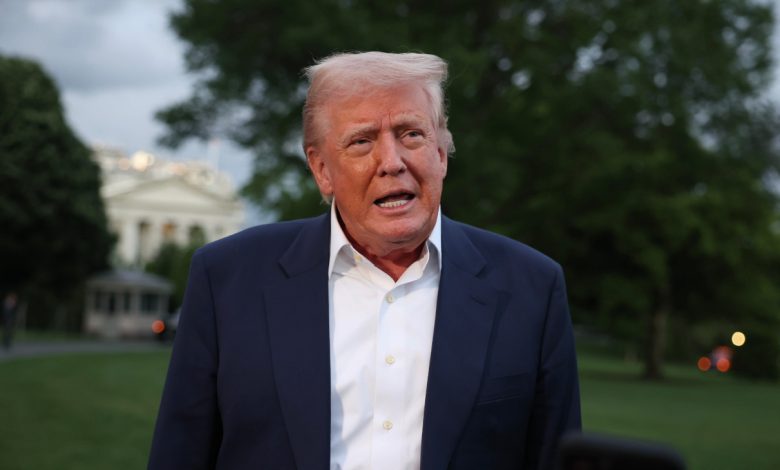Trump’s 100 Percent Tariff on Movies: 8 Key Questions the Industry Is Now Pondering and Dreading

Of course, it was too good to be true.
For the first 100 days of Donald Trump‘s second presidency, it looked like the entertainment industry might just escape the huge costs and relentless chaos unleashed by his radical attempts to remake global trade.
اRelated Posts:
Entertainment products like movies were exempt from Trump’s original “Liberation Day” tariffs because they are classified as services, rather than physical goods. The industry also took some assurance from the fact that film and series, much like big tech, represent one of the United States’ strongest trade surpluses, because of how much more Hollywood blockbusters bring in from abroad compared to foreign content’s slim earnings within the United States. But in a Sunday night post to Truth Social, the president revealed — in screaming all-caps — that he’s targeting the film business next.
“The Movie Industry in America is DYING a very fast death,” Trump wrote. “Other Countries are offering all sorts of incentives to draw our filmmakers and studios away from the United States. Hollywood, and many other areas within the U.S.A., are being devastated. This is a concerted effort by other Nations and, therefore, a National Security threat. It is, in addition to everything else, messaging and propaganda!”
He continued: “Therefore, I am authorizing the Department of Commerce, and the United States Trade Representative to immediately begin the process of instituting a 100% Tariff on any and all Movies coming into our Country that are produced in Foreign Lands. WE WANT MOVIES MADE IN AMERICA, AGAIN!”
Commerce Secretary Howard Lutnick replied to Trump’s statements on X (formerly Twitter) by writing, “We’re on it.”
Jon Voight, whom Trump named one of his “special ambassadors” to Hollywood, is the instigator of the president’s sudden interest in film production, according to several sources contacted by THR. The actor and his manager Steven Paul have been taking meetings with leaders of the Hollywood guilds and studios about a proposal to Trump for how to boost U.S. production with a domestic film incentive. So far, the president appears to have interpreted that advice in the punitive language he prefers — tariffs as stick, rather than incentive as carrot.
From the global film industry, the early reaction is a predictable mix of dread and total confusion.
“Hollywood is a flagship industry and it was naive to think it wouldn’t be impacted by Trump’s broader tariff war,” says Henning Molfenter, the former head of film and TV production at Germany’s Studio Babelsberg, who has overseen the international shoots of such big-budget U.S. features as the Russo Brothers’ Captain America: Civil War and Lana Wachowski’s The Matrix Ressurections, as well as Wes Anderson’s upcoming feature, The Phoenician Scheme, which will premiere in Cannes. “But it’s not clear what will be impacted. Is it just movies, or also streaming series? Is it visual effects, co-productions, international film financing? There’s a huge degree of uncertainty.”
Molfenter echoes a common refrain: “How could this even work?”
At the risk of sane-washing a policy that may or may not ever come to pass, here are eight key questions the industry will be pondering and considering as potential ammunition to push back against the president’s characteristically blunt opening salvo on the film sector.
What films will be hit by tariffs, and will it be retroactive?
The studios have been shooting their biggest films overseas for years, both to take advantage of visually stunning foreign locations and generous rebates and tax incentives to lower their production costs. Paramount’s Mission: Impossible – The Final Reckoning, also heading to Cannes, tapped tax credits in the U.K. and other territories to offset its hefty production budget. Warner Brothers and Legendary Pictures’ A Minecraft Movie, the biggest blockbuster of 2025, so far, was mostly shot in New Zealand, with some production in Canada. Likewise, James Cameron’s Avatar franchise, backed by Disney, shot entirely in New Zealand. Marvel’s Avengers: Doomsday recently began production in London. The list goes on.
Would Trump’s tariffs apply retroactively to films that have already shot or that have already begun production? If so, the cost to the studios could be enormous. Roughly 45 percent of A Minecraft Movie‘s $875 million global box office haul — the $400 million it made at the U.S. box office — could theoretically be susceptible to Trump’s 100 percent tariff.
And how will the Trump administration classify movies “produced in foreign lands”? Does including any scene shot outside the U.S. qualify? Does a certain percentage of a film’s budget have to come from international production incentives? So far, none of this is clear.
What about Netflix?
Trump’s initial social media missives only mentioned “movies,” but many in the industry assume any entertainment tariff would also apply to series production. That would be a huge blow to Netflix and other streamers — Amazon, Disney+, HBO Max — which have been built on a model of leveraging local production across a global subscriber base. Would Netflix have to pull Squid Game, Money Heist and The Crown from its U.S. service or face tariffs? And how would tariffs even be calculated for the streamers, which offer countless foreign-made titles to U.S. customers? How much of Netflix’s U.S. subscription revenue can be attributed to non-U.S.-produced shows?
Would a tariff bring production back to the United States?
Trump isn’t all wrong when he says film production in America “is DYING.” A report last month from FilmLA, the nonprofit group that handles film permits for the city and county, showed shooting in L.A. decreased more than 22 percent over the three-month period from January to March this year. More than a year after the two strikes that brought the U.S. film and TV business to a standstill, production has not returned in force to L.A. While some production has simply moved across state borders — Marvel has filmed many of its biggest titles in Atlanta, taking advantage of the state’s 30 percent tax credit — there is no doubt runaway production, to London, to Vancouver, to Budapest, Hungary, and Christchurch, New Zealand — has led to a sharp drop in America-made movies. FilmLA reports production has dropped nearly 40 percent in the past decade, and the most recent report from movie industry research firm ProdPro shows production spending in the U.S. overall was $14.54 billion last year, down 26 percent since 2022.
But would a movie tariff actually bring back film production? The main reason the studios and independents go abroad to shoot is money. Making a film in the U.S., which lacks federal tax incentives of the sort found in the U.K., Europe or Australia, can be 30 to 40 percent more expensive. Add to that the cost of U.S. crews, which are pricier than their international counterparts — thanks in part to the strength of American film and TV unions — and it’s unclear whether a tariff would be enough to bring production back home.
Without a domestic rebate to offset the lost incentives abroad, the increased costs of filmmaking in the U.S. will likely mean that studio movies get smaller — or become more digital, with more volume stage and greenscreen shooting or more use of artificial intelligence (though that could create new problems with the guilds, which have strict restrictions on the use of AI).
For small and mid-size independent productions, a tariff could simply mean those films don’t get made.
How will other countries respond?
With Trump’s Liberation Day tariffs, many countries had limited recourse for retaliation because the U.S. trade deficit on physical goods in nearly all nations is so enormous. That’s not true for entertainment. The U.S. exports nearly three times as much entertainment as it imports, according to the MPA. Figures from the European Audiovisual Observatory, a media industry think tank, show that U.S. films accounted for 71.1 percent of cinema admissions in Europe in 2023, the latest year for which figures are available, with locally made movies making up just over 25 percent of sales. A tit-for-tat tariff response by international governments would jack up the price of U.S. movies abroad, and, for Hollywood, still struggling to recover from a post-COVID box office dip, it could be devastating.
What happens to the foreign-language distribution business?
Buying foreign-language films for the U.S. has always been a tough business. Trump’s tariffs could make it nearly impossible. Will the small number of successful international film buyers in the U.S. — Neon, Mubi, Sony Pictures Classics — still afford to buy and release the finest French, German and Japanese films in North America when they will cost twice as much under Trump’s tariff? What would it mean for American intellectual life to be effectively walled off from much of the world’s finest cinema?
What about postproduction?
In the same way that they have created production incentives to lure film shooting to their shores, many foreign governments offer similar rebates for postproduction work done within their borders. Would Trump’s movie tariff also target postproduction work completed outside the U.S.? If so, what would become of the likes of New Zealand’s fabled Weta FX and Weta Workshop, Netflix’s Scanline VFX (in Canada and Europe) and the U.K.’s Double Negative and Framestore, among others? More than any other sector of the business, post-production has become truly global. Can Trump put an end to that?
Can international co-productions survive?
In its ongoing fight for survival, the indie film community has learned to use every tool at its disposal to get its movies made — and more often than not, that has meant shooting abroad for rebates and leveraging foreign grants through co-production arrangements. Brady Corbet’s multi-Oscar nominated indie triumph The Brutalist — made for just $9.6 million — probably wouldn’t have been possible in its finished form had it not been set up as a Hungarian/U.K./U.S. co-production, taking advantage of multiple tax incentives and production subsidies, and shot in low-cost Budapest. Mid-budget action movies — pretty much every Gerard Butler, Liam Neeson or Jason Statham shoot-’em-up you can think of — rely on budget crews and tax incentives, mainly in Eastern European countries, to make the numbers work. The bulk of new projects being packaged and pitched for the Cannes film market next week involve some form of international co-production or non-U.S. shoot. Has Trump killed the Marche?
Will this actually happen?
At this point in the Trump show, the famously unpredictable president seems to be following a script as tired as any other long-running, low-brow procedural. How likely is it that Trump’s movie tariff will endure in its initial, blunt and far-reaching form, or will it eventually get watered down like many of his other art-of-the-dumb-deal opening gambits? So far, markets seem to be only mildly concerned. Amid a broader slip in stock futures, Disney’s stock was down just over 3 percent in pre-market trading, while Netflix was under by 6 percent and Warner Brothers Discovery down about 4 percent.
Source: Hollywoodreporter
HiCelebNews online magazine publishes interesting content every day in the TV section of the entertainment category. Follow us to read the latest news.
Related Posts
- Prince George, Princess Charlotte and Prince Louis Make Rare Appearance for Historic VE Day Outing
- Meet Kelly Ripa and Mark Consuelos’ daughter Lola’s British boyfriend Cassius Kidston
- Why Lorne Michaels Would Allegedly Ban Chris Farley From ‘SNL’ For “Weeks at a Time”
- Lady Gaga Draws Record-Breaking 2.5 Million People to Brazil Beach for ‘Mayhem’ Concert
- Beyoncé and Jay-Z go for contrasting outfits as they make a date night out of family’s celebratory event on tour





